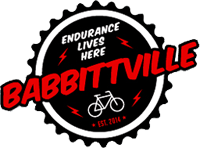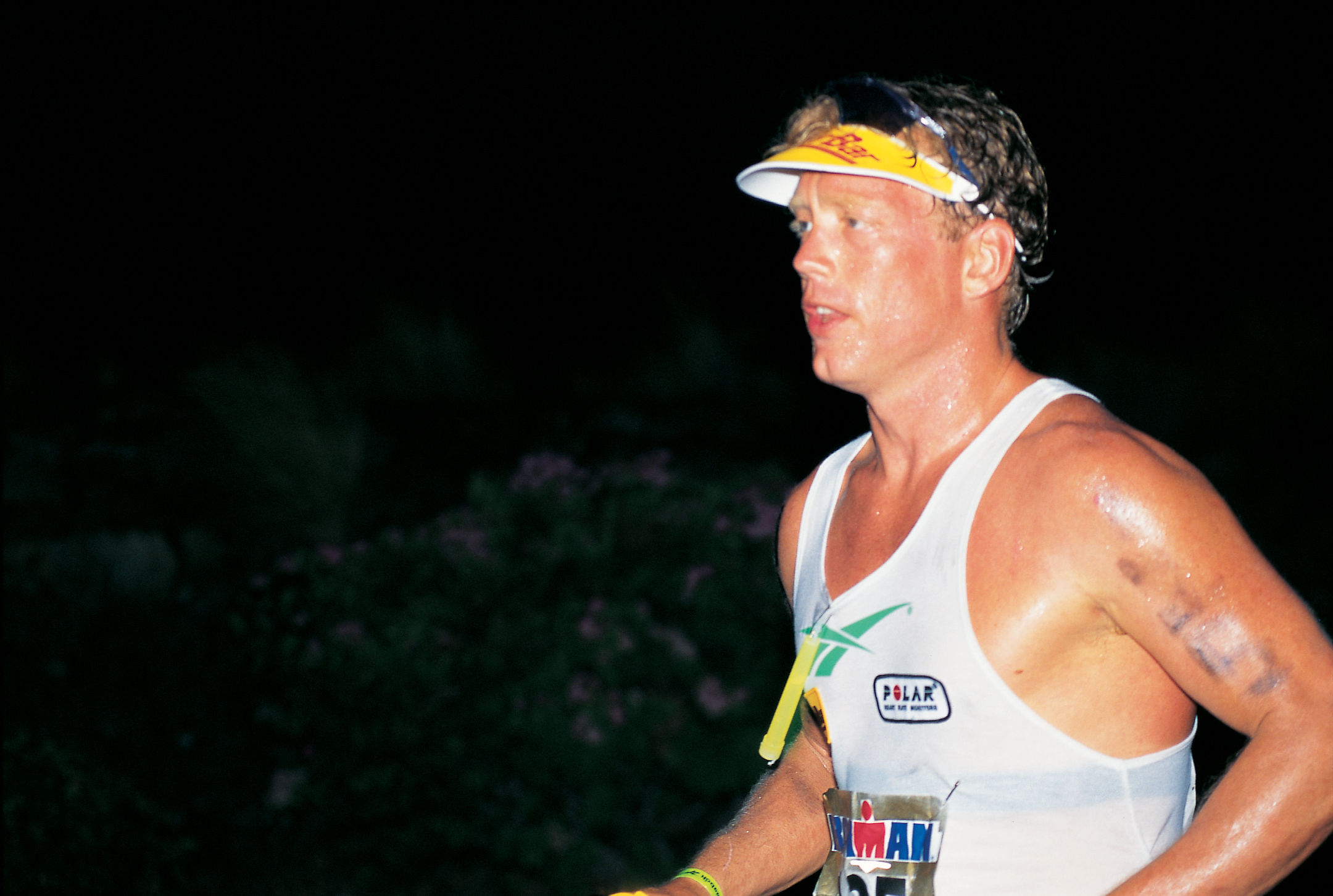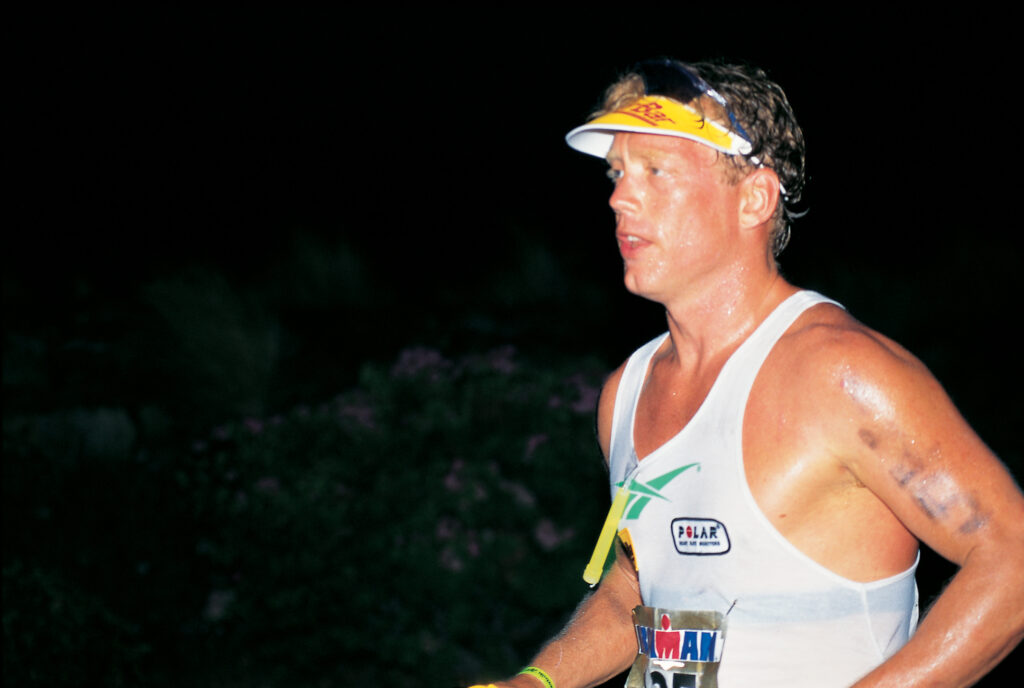Remembering Jim Howley, 12/12/1960 – 7/29/2025
As we remember Jim, who passed away on July 29th after a battle with cancer, we’re sharing this piece I wrote about Jim in 1996 for my 25 Years of the Ironman Triathlon World Championship coffee table book.
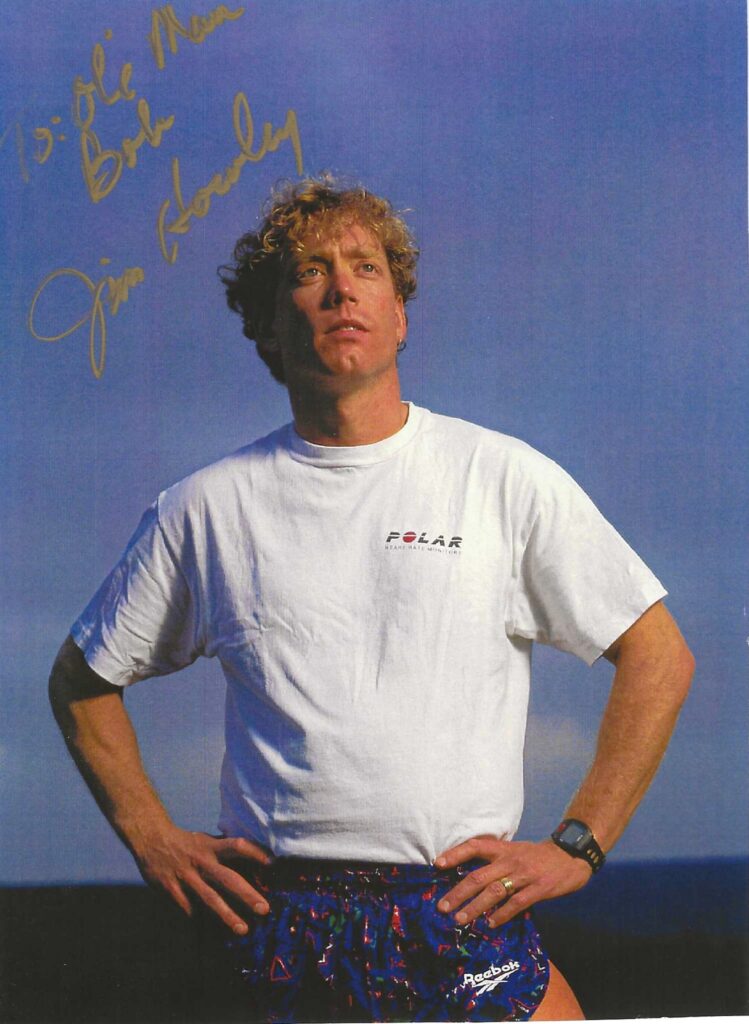
It’s May 1996 and the sun is setting behind the green hills that surround Lake San Antonia in Central California. Most of those watching old sol’s hasta la vista are still splattered with sweat and tattooed with race numbers from their Wildflower Half Ironman adventure earlier in the day. They had gone head to head with 1.2 miles of swimming, 56 miles of cycling and 13.1 miles of running.
H2….Hills and Headwinds, are what makes Wildflower such a worthy adversary.
The assembled multitudes, the humbled conquerors, have either placed in their age division and are waiting to collect their award, or they are hoping beyond hope that their name will be drawn at random and they will own a spot in the coveted Gatorade Ironman bike rack. Only winners of each age group are assured a spot in Kailua Bay in October.
The wind picks up and scatters leaves and burrito wrappers as the announcer drones on. Jim Howley, 34, who is working on his master’s in clinical psychology, is one of those anxiously awaiting the lottery call. He knows the odds are bad but – trust me on this – he has definitely seen worse.
Howley has AIDS. Full-blown AIDS.
“Most people would expect him to be dead by now,” says Dr. Gary Cohan, his physician for the past two years. For 12 years, Howley has been HIV positive. For nearly six years, he has had AIDS. The average “healthy” person has 800 – 1,000 T-cells, the guys that fight off infection. Howley has between four and eight. Not 400. Four.
He basically has absolutely no immune system.
“Jim is doing well,” admits Dr. Cohan. “He has outlived the odds and he is living day to day. But you can’t rebuild the immune system. All we can do is try to preserve the T-cells Jim has left.”
Since he found out he had AIDS, Howley has run the Los Angeles Marathon five times and completed numerous triathlons, including this year’s Wildflower event – with a pulled hamstring – finishing in a time of 6:39.
What actually happens to an AIDS patient is that they develop what Dr. Cohan refers to as the wasting syndrome.
“In healthy people, if they starve, they lose fat, which is non-essential,” says Dr. Cohan, a board-certified internist and assistant clinical professor at UCLA. “When you have AIDS, the metabolic pathway is uncoupled and the body chews up lean body mass and vital organs. By working out, Jim has been able to keep his lean body mass.”
In the past, exercise wasn’t even a consideration for AIDS patients.
“We tended not to pay attention to exercise,” says Dr. Cohan. “Exercise has never been encouraged. Frankly, it’s been ignored. I’ve just started speaking about AIDS and exercise recently.”
Howley does what no AIDS patient has done before. Each week, he runs 35 miles, cycles 150 and swims five to six miles. He takes 60 pills a day to help combat the ravages of AIDS.
“Since I have no immune system, I can get sick from tap water,” says Howley. “The pills I take make me sick….but they also keep me from getting sick at the same time.”
One of the pills he takes, Marinol, is a marijuana pill designed to give him the munchies so that he can eat enough to keep his weight up. At the moment, he is a robust 193 pounds.
When he first learned that he was HIV positive 12 years ago, Howley started doing 2-3 grams of cocaine a day and anything else that would make him feel good. When he took another test six years ago and found out that he had AIDS, he thought is was all over.
“[Doctors] told me not to even go into a crowded movie theater,” he recalls. “That’s how bad it was. I freaked out. I went home and decided that before I die, I want to do a triathlon. I went to a pool that day and wasn’t able to swim to the other side.”
His first triathlon was in Cerritos in 1990. “That race changed me forever. This has been the best five years of my life because of triathlon.”
His life has touched to entire Santa Barbara triathlon community. Gary Flacke, a long-time professional triathlete, remembers Howley showing up at Saturday morning 5K runs and always finishing last.
“He wasn’t good at all,” laughs Flacke. “But he was always so upbeat.”
Howley has worked his way up to the middle of the pack and seems to be loving every minute of it.
“He is never bummed,” admits Flacke. “I didn’t know about Jim having AIDS for two years after I met him. I was so impressed with him as a person by that point, I admired him so much, that it didn’t make a difference.”
The goal now is Ironman Hawaii. Last year would have been nice. This year would be awesome.
“He really wanted to get in last year,” remembers Flacke. “When he didn’t get in at Mike and Rob’s Triathlon, you could tell he was close to tears.”
Friends from the Santa Barbara Triathlon community got together and put up $30 each to enter Howley in the Ironman lottery and the Ironman passport club this year. They did it without his knowledge.
At dinner one night, his friends presented Howley with a card adorned with his name and the Ironman logo.
When he found out that he didn’t get in through the lottery, he set off for Wildflower. The half Vineman is later this summer and if necessary, he’ll go to Mike and Rob’s Triathlon on August 13.
“There’s not a question that he can finish Ironman,” insists Flacke. “No way he wouldn’t finish that race.”
Ironman or no Ironman, Howley is already in a race. It’s a race against time and it’s a race to spread his message.
“Twelve years ago, when I first found out I was HIV positive, most guys were blowing their brains out,” he says. “Now I’m getting calls from all over the world from other AIDS patients. Their doctors are telling them not to do anything. I’m trying to get them to buy bicycles, to start running or swimming. It works.”
He pauses as the wind picks up around us.
“The switch is either on or off. If it’s off, they’re just going to go and die. I was forced to grab life. Basically, I train to stay alive.”
A few weeks later, we speak again. At the end of our conversation, Howley says that he won’t be able to swim, ride or run for 10 days or so. Something about a minor eye problem.
Speaking with Dr. Cohan later that day, I ask about the eye situation. Typically, Jim has understated the problem.
“Jim has a sight-threatening eye infection,” Dr. Cohan tells me. “We have to operate and then treat it with medication.”
“Without an immune system, Howley is a bacteria magnet. Little problems that our bodies, our T-cells, would take care of, can kill him.
Which makes what he has accomplished that much more amazing.
“He’s an inspiration,” says D. Cohan. “He’s far and away the most active person – in terms of competition – of the over 1,000 AIDS patients I have worked with. Jim is one of those guys who can push the edge of the envelope.”
The message Howley is sending to other AIDS patients?
“That you shouldn’t live with one foot in the grave,” says Dr. Cohan. “And that it ain’t over ‘til the Fat Lady sings.”
The Fat Lady hasn’t even begun to warm up her vocal chords yet. A certain someone still has to secure his spot in the biggest tri-show on Earth.
Postscript
Jim Howley was told that the type of training he would need to do for the Ironman would kill someone with AIDS. He proved them all wrong when he completed the toughest day in sport. Jim shocked the world in 1996 when, with AIDS, he finished the Ironman in 14:47:22. To prove it wasn’t a fluke, he came back in 1997 and went 13:14:55, over an hour and a half faster.
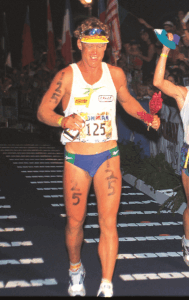
Jim Howley finishing the Ironman Triathlon World Championship
